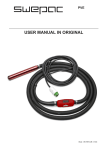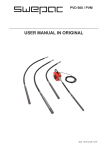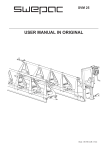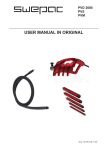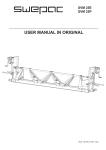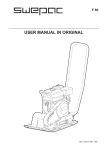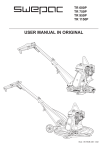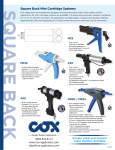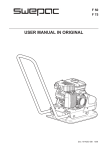Download USER MANUAL IN ORIGINAL
Transcript
PVCE 2,5 230V PVCE 2,5 400V USER MANUAL IN ORIGINAL Dok: 101508-GB 1324 PVCE 2,5 230V / PVCE 2,5 400V CONTENTS SAFETY INSTRUCTIONS...................................... 3 OPERATION, PRECAUTIONS...............................3; 4; 5; 6 TRANSPORT, PRECAUTIONS..............................6 TECHNICAL DATA................................................7 EU DRIVE USER MANUAL..................................8 NOTES.....................................................................9; 10 Dok: 101508-GB 1324 EC-DECLARATION OF CONFORMITY..............11 2 PVCE 2,5 230V / PVCE 2,5 400V SAFETY INSTRUCTIONS To reduce the risk of serious injury or death to yourself or others read and understand the Safety and operating instruction before installing, operating, repairing, maintaining, or changing accessories on the machine. Post this Safety and operating instruction at work locations, provide copies to employees, and make sure that everyone reads the Safety and operating instruction before operating or servicing the machine. In addition, the operator or the operator’s employer must assess the specific risks that maybe present as a result of each use of the machine. Additional instructionst for the engine can be found in the manufacturer’s engine manual. Personal precautions and qualifications Only qualified and trained persons may operate or maintain the machine.They must be physically able to handle the bulk, weight, and power of the machine. Always use your common sense and good judgement. Personal protective equipment Always use approved protective equipment. Operators and all other persons in the working area must wear protective equipment,i ncluding at a minimum: OPERATION, PRECAUTIONS DANGER Explosion hazard If a warm machine or exhaust pipe comes into contact with explosives, an explosion couldoccur. During operating with certain materials, sparks and ignition can occur. Explosions will lead to severe injuries or death. Never operate the machine in any explosive environment. Never use the machine near flammable materials, fumes or dust. Make sure that there are no undetected sources of gas or explosives. Avoid contact with the warm exhaust pipe or the bottom of the machine. DANGER Fire hazard If a fire starts in the machine, it can cause injury. If possible use an ABE-class powder extinguisher, other wise usea BE-type carbon dioxide fire extinguisher. DANGER Fuel hazard • Protective helmet • Hearing protection • Impact resistant eye protection with side protection • Respiratory protection when appropriate • Protective gloves • Proper protective boots • Appropriate work overall or similar clothing (not loose-fitting) that covers your arms and legs. Drugs, alcohol or medication Drugs, alcohol or medication may impair your judgment and powers of concentration. Poor reactions and incorrect assessments can lead to severe accidents or death. Never use the machine when you are tired or under the influence of drugs, alcohol or medication. Dok: 101508-GB 1324 No person who is under the influence of drugs,alcohol or medication may operate the machine. 3 PVCE 2,5 230V / PVCE 2,5 400V Only store fuel in a container that is specially constructed and approved for the purpose. If the machine has an exhaust, direct the exhaust so as to reduce disturbance of dustin a dust filled environment. Consumed fuel and oil containers must be taken care of and returned to the retailer. Operate and maintain the machine as recommended in the operating and safety instructions. Never use your fingers to check for fluid leaks. Wear washable or disposable protective clothes at the worksite, and shower and change in to clean clothes before leaving the work site to reduce exposure of dust and fumes to your self, other persons, cars, homes, and other areas. WARNING Unexpected movements The machine is exposed to heavy strains during operation.If the machine breaks or gets stuck, there maybe sudden and unexpected movemen that can cause injuries. Always inspect the machine prior to use. Never use the machine if you suspect that it is damaged. Make sure that the handle is clean and free of grease and oil. Keep your feet away from the machine. Never sit on the machine. Never strike or abuse the machine. Pay attention and look at what you are doing. WARNING Dust and fume hazard Dusts and /or fumes generated or dispersed when using the machine may cause serious and permanent respiratory disease, illness, or other bodily injury (forexample, silicosis or other irreversible lung disease that can be fatal, cancer, birth defects, and /or skin inflammation). Some dusts and fumes created by compaction work contain substances known to cause respiratory disease, cancer, birth defects, or other reproductive harm. Dust and fumes in the air can be invisible to the naked eye, so do not rely on eye sight to determine if there is dust or fumes are the air. To reduce the risk of exposure to dust and fumes, do all of the following: Perform site-specific risk assessment. The risk assessment should include dust and fumes created by the use of the machine and the potential for disturbing existing dust. Wear, maintain and correctly use respiratory protection as instructed by your employer and as required by occupational health and safety regulations. Ther espiratory protection must be effective for the type of substance at issue (and if applicable, approved by relevant governmental authority). 4 Work in a well ventilated area. Avoid eating,drinking, and using tobacco products in areas where there is dust or fumes. Wash your hands and face thoroughly as soon as possible upon leaving the exposure area,and always before eating, drinking, using tobacco products,or making contact with other persons. Comply with all applicable laws and regultions, including occupational health and safety regulations. Participate in air monitoring, medical examination programs, and health and safety training programs provided by your employer or trade organizations and in accordance with occupational health and safety regulations and recommendations. Consult with physicians experienced in relevant occupational medicine. Work with your employer and trade organization to reduce dust and fume exposure at the work site and to reduce the risks. Effective health and safety programs, policies and procedures for protecting workers and others against harmful exposure to dust and fumes should be established and mplemented based on advice from health and safety experts. Consult with experts. DANGER Exhaust gas hazard The exhaust gas from the machine’s combustion engine contains carbon monoxide which is poisonous, and chemicals which cause cancer, birth defects, or other reproductive harm. Inhalation of exhaust fumes can cause serious injury, illness, or death. Never inhale exhaust fumes. Ensure good ventilation (extraction of air by fan if necessary). Dok: 101508-GB 1324 Never smoke when filling the fuel tank or when working with the machine or servicing it. PVCE 2,5 230V / PVCE 2,5 400V WARNING Projectiles Failure of the work piece, of accessories, or even of the machine itself may generate high velocity projectiles. During operating, splinters or other particles from the compacted material may become projectiles and cause personal injury by striking the operator or other persons.To reduce these risk: Use approved personal protective equipment and safety helmet, including impact resistant eye protection with side protection. Make sure that no unauthorised persons trespass into the working zone. Keep the work place free from foreign objects. If numbness, persistent recurring discomfort, burning sensation, stiffness, throbbing, tingling, pain, clumsiness, weakened grip,whitening of the skin, or other symptoms occurat any time, when operating the machine or when not operating the machine, stop operating the machine, tell your employer and seek medical attention. Continued use of the machine after the occurrence of any such symptom may increase the risk of symptoms becoming more severe and /or permanent. Operate and maintain the machine as recommended in these instructions, to prevent an unnecessary increase in vibration. WARNING Rotating blades hazards The following may help to reduce exposure to vibration for the operator: There is a risk of hands and feet getting caught by the rotating blades when the machine is running. This can cause personal injury. If the machine has vibration absorbing handles, keep them in a central position, avoid pressing the handles into the end stops. Never place your hands or feet inside the protection ring when the machine is running When the percussion mechanism is activated, the only body contact with the machine yous hould have are your hands on the handle or handles. Avoid any other contact, for example supporting any part of the body against the machine or leaning onto the machine trying to increase the feed force. WARNING Motions hazards When using the machine to perform work-related activities, you may experience discomfort in the hands, arms, shoulders, neck, or other parts of the body. Adopt a comfortable posture whilst maintaining secure footing and avoiding awkward off-balanced postures. Changing posture during extended tasks may help avoid discomfort and fatigue. Make sure that the machine is well-maintained and not worn out. Immediately stop working if the machine suddenly starts to vibrate strongly. Before resuming the work, find and remove the cause of the increased vibrations. In case of persistent or recurring symptoms, consult a qualified health professional. Participate in health surveillance or monitoring, medical exams and training programs offered by your employer and when required by law. WARNING Vibrations hazards When working in cold conditions wear warm clothing and keep hands warm and dry. See the”Noise and vibration declaration statement”for the machine, including the declared vibration values. This information can be found at the end of these Safety and operating instructions. Dok: 101508-GB 1324 Normal and proper use of the machine exposes the operator to vibration.Regular and frequent exposure to vibration may cause, contribute to, or aggravate injury or disorders to the operator’sf ingers, hands, wrists, arms, shoulders and/or nerves and blood supply or other bodyparts, including debilitating and/or permanent injuries or disorders that may develop gradually over periods of weeks, months, or years.Such injuries or disorders may include damage to the blood circulatory system, damage to the nervous system, damage to joints, and possibly damage to other body structures. 5 PVCE 2,5 230V / PVCE 2,5 400V Never grab or touch a rotating machine part. Avoid wearing clothing, neck ware or gloves that may get caught. Cover long hair with a hair net. DANGER Electrical hazard The machine is not electrically insulated. If the machine comes in to contact with electricity, serious injuries or death may result. Never operate the machine near any electric wire or other source of electricity. Make sure that there are no concealed wires or other sources of electricity in the working area. DANGER Concealed object hazard During operating, concealed wires and pipes constitute a danger that can result in serious injury. Check the composition of the material before operating. Watch out for concealed cables and pipes for example electricity, telephone, water, gas, and sewage lines. If the machine seems to have hit a concealed object, switch off the machine immediately. Make sure that there is no danger before continuing. WARNING Involuntary start Involuntary start of the machine may cause injury. Keep your hands away from the start and stop device until you are ready to start the machine. Learn how the machine is switched off in the event of an emergency. WARNING Noise hazard High noise levels can cause permanent and disablinghearing loss and other problems such as tinnitus(ringing, buzzing, whistling, or humming in the ears).To reduce risks and prevent an unnecessary increase in noise levels: Risk assessment of these hazards and implementation of appropriate controls is essential. Operate and maintain the machine as recommended in these instructions. If the machine has as ilencer, check that it is in place and in good working condition. Always use hearing protection. 6 TRANSPORT, PRECAUTIONS WARNING Loading and unloading hazard When the machine is lifted by a crane and similar appliance, this can lead to injury. Use marked lifting points. Make sure that all lifting devices are dimensionedfor the weight of the machine. Never remain under or in the immediate vicinity of the machine. MAINTENANCE, PRECAUTIONS WARNING Unexpected start hazard During maintenance or when changing blades on the machine, there is a risk that the engine backfires or that the machine unexpectedly starts. This applies especially when the engine is hot and if the switch is in position ON.This can result in serious personal injury. Always let the engine cool down. Always turn the switch to position OFF. Always take the cap off the spark plug. WARNING Unexpected start hazard Any machine modification may result in bodily injuries to yourself or others. Never modify the machine. Modified machines are not covered by warranty or product liability. Always use original parts, insertion tools, and accessories. Change damaged parts immediately. Replace worn components in good time. CAUTION High temperature The machine’s engine exhaust pipe, and bottom become hot during operation. Touching them can lead to burns. Never touch a hot machine. Never touch the bottom of the machine when its hot. Wait until the engine, exhaust pipe, and bottom of the machine have cooled down before carrying out maintenance work. STORAGE, PRECAUTIONS Keep the machine in a safe place, out of the reach of children and locked up. Dok: 101508-GB 1324 WARNING Trapping hazards There is a risk of neck ware, hair, gloves, and clothes getting dragged into or caught by rotating machineparts.This may cause choking, scalping, lacerations, or death.To reduce the risk: PVCE 2,5 230V / PVCE 2,5 400V TECHNICAL DATA PVCE 2,5 230V Power.............................................................2.5 kVA Primary voltage.............................................230 V, 1-phase 50 Hz Secondary voltage.........................................42 V, 200 Hz Output current...............................................35 A Outlet sockets................................................2 Weight...........................................................21 kg PVCE 2,5 400V Power.............................................................2.5 kVA Primary voltage.............................................400 V, 3-phase 50 Hz Secondary voltage.........................................42 V, 200 Hz Output current...............................................35 A Outlet sockets................................................2 Weight...........................................................20 kg EU Series inverter have the following advantages: Dok: 101508-GB 1324 Strong output power Considerably lower weight compared to rotary converters Significantly lower noise level compared to rotary converters Up to 4 connections Designed for harsh construction sites Shutdown with overload and immediate restart Phase Monitoring - Protecting the HF internal vibrators Automatic power control - up to 150% overload No wearing parts 7 PVCE 2,5 230V / PVCE 2,5 400V EU DRIVE USER MANUAL OPERATING INSTRUCTIONS FOR FREQUENCY OF SERIES EU 1 Generally Commissioning and repairs are carried out by qualified personnel (VDE 0100 and VDE 0110). Improper installation of these vibrators equipment failure or even fatal injury. Follow the instructions listed below, as well as national and local safety regulations. After disconnecting the device from the network are the first link, link and commutation capacitors and other capabilities continue to live. The discharge may take longer than 3 minutes. Before starting work, the absence of voltage in the power circuit must be checked. The warranty provisions in force at the time of purchase are valid for the device. For improper use of the equipment no liability. Any unauthorized modification to the equipment, including the faulty installation of Zusatzeinrichtunfen, may cause a change in the data and the content of documentation and instructions to follow and leads to an exclusion of our liability and warranty. WARNING Do not open the unit in the connected input voltage. Open only for routine inspections to check the internal connection cables. Making sure that the device was unplugged at least 10 minutes. It must be ensured that the DC bus has discharged Kondenator! Do not operate the unit with the housing open. Do not operate the unit as specified by higher input voltage in this manual. Do not operate with wet hands. Switch Please note that in case of overload, the inverter restarts 3 times within one second. Clean the unit with it pressure washers! Do not operate the unit in motor input voltage generators! This can produce a power surge that damages the drive. FI - SWITCH The frequency with input voltage 230 V AC can be connected and operated only at ≤ 30 mA power supply with RCD (type B). Attention: Due to the high leakage of the interference filter, make sure that only the converter is connected to a GFCI. This undesired tripping of the RCD is prevented. 8 Dok: 101508-GB 1324 The frequency with input voltage 3 x 400 V, only on power supplies with DC sensitive residual current devices (Type B) can be connected and operated ≤ 30 mA. Should this not be due to high leakage currents (due to EMC filter) is possible, a differential current monitoring device must be used. PVCE 2,5 230V / PVCE 2,5 400V Dok: 101508-GB 1324 NOTES 9 PVCE 2,5 230V / PVCE 2,5 400V Dok: 101508-GB 1324 NOTES 10 PVCE 2,5 230V / PVCE 2,5 400V EC-declaration of conformity Manufacturer Swepac AB Blockvägen 3 34132 Ljungby 1. Category: Electronic frequency converter 2. Type: PVCE 2,5 230V PVCE 2,5 400V The product complies with the following directives: 2006 / 42 / EG 2000 / 14 /EG 2004 / 108 / EG EN 500-1 EN 500-4 EN 12649:2008+A1:2011 ISO 11201 ISO 5349-2:2001 Technical documentation held by: Dok: 101508-GB 1324 Swepac AB, Blockvägen 3 SE-34132 Ljungby Hans Holmlund / Product Manager 11 SWEPAC AB Address Blockvägen 3, 341 32 Ljungby, Sweden, tel. +46 (0)372-156 00, fax +46 (0)372-837 41, E-mail [email protected], Internet www.swepac.se













